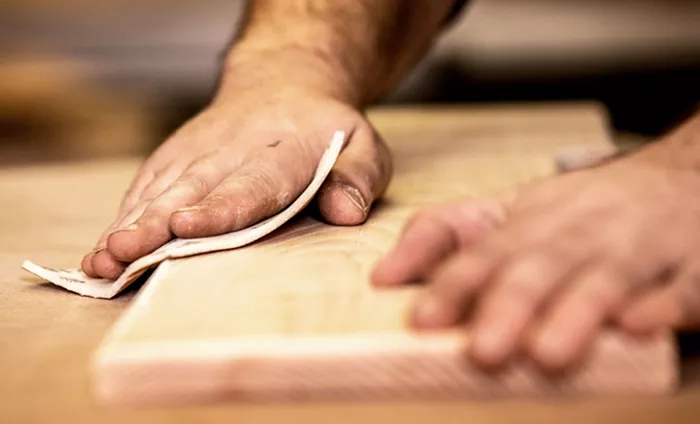When working with wood, selecting the right sandpaper grit is crucial for achieving a smooth and polished finish. Sandpaper is categorized by its grit number, which indicates the size of the abrasive particles on its surface. Lower grit numbers mean larger, more aggressive particles, while higher grit numbers represent finer particles that provide a smoother finish.
Coarse Grit Sandpaper (40 to 60 Grit)
Best for Heavy Material Removal: Coarse grit sandpaper, typically ranging from 40 to 60 grit, is ideal for initial sanding stages. This grit is used when you need to remove old paint, varnish, or rough wood quickly. It’s also effective for shaping wood and leveling uneven surfaces. However, be cautious with coarse grits as they can leave deep scratches that need to be smoothed out in later sanding stages.
Medium Grit Sandpaper (80 to 120 Grit)
Perfect for General Wood Sanding: Medium grit sandpaper is the most commonly used in woodworking projects. Grits ranging from 80 to 120 are perfect for removing minor imperfections and smoothing wood surfaces after using coarse grit. It’s suitable for preparing wood surfaces before applying finishes like paint, stain, or varnish. Medium grit provides a balance between material removal and surface smoothness.
See also: How To Wire A Ceiling Fan: A Comprehensive Guide
Fine Grit Sandpaper (150 to 180 Grit)
Ideal for Surface Preparation: Fine grit sandpaper, typically between 150 and 180 grit, is used for the final preparation of the wood surface before applying the finish. This grit smoothens the wood to a point where it’s ready for staining or painting. It removes minor scratches left by the previous sanding stages and ensures a uniform surface that enhances the finish’s appearance.
Very Fine Grit Sandpaper (220 to 240 Grit)
For Final Smoothing: Very fine grit sandpaper, in the range of 220 to 240 grit, is used for the final sanding before applying the finish. It’s especially useful for softwoods, as it ensures the wood surface is as smooth as possible. This grit also helps to achieve a more professional look by eliminating any remaining minor imperfections.
Extra Fine Grit Sandpaper (320 to 400 Grit)
Best for Finishing Touches: Extra fine grit sandpaper, ranging from 320 to 400 grit, is used after the finish has been applied. It’s great for smoothing between coats of paint, varnish, or polyurethane. This grit helps to create a smooth, glossy finish by eliminating any bubbles or dust particles that may have settled during the drying process.
Ultra-Fine Grit Sandpaper (600 and Above)
For the Ultimate Smooth Finish: Ultra-fine sandpaper, with grit numbers of 600 and above, is often used in polishing or buffing stages, especially for high-gloss finishes. This grit can be used on wood, but it’s more commonly applied to metal or plastic surfaces where a mirror-like finish is desired. When used on wood, it’s typically in the final stages of finishing or for delicate sanding of thin, delicate materials.
See also: How To Get Stripped Screw Out?
Choosing the Right Sandpaper for Your Project
When selecting sandpaper grit for wood, it’s essential to consider the stage of your project and the type of wood you’re working with.
For rough, unfinished wood: Start with coarse grit to remove large imperfections.
For smoothing and preparing the surface: Use medium grit to eliminate any scratches left by the coarse sandpaper.
For final preparation: Fine to very fine grit sandpaper is ideal for ensuring a smooth surface ready for finishing.
For finishing: Extra fine or ultra-fine grit sandpaper helps to achieve a professional and polished finish.
Tips for Sanding Wood
Always sand with the grain: to avoid scratches that can be difficult to remove.
Use a sanding block or an orbital sander: for even pressure distribution.
Work progressively through the grits: Start with a lower grit and move to a higher one for the best results.
Clean the wood surface between grits: This helps to remove any dust or debris that could cause scratches.
Conclusion
Selecting the right grit sandpaper for wood is essential for achieving a smooth, professional finish. By understanding the purpose of each grit level and following proper sanding techniques, you can enhance the quality of your woodworking projects. Whether you’re removing old finishes, smoothing out rough surfaces, or preparing for a final coat, choosing the appropriate sandpaper grit will ensure your woodwork looks its best.
Related Topics:
-
Top 5 Torque Wrenches For Precision And Performance: A Full Evaluation
-
The Ultimate Guide To The Best Tape Measures For Construction And Carpentry
-
Ultimate Guide To The Ryobi Electric Pressure Washer: Features, Benefits, And Reviews
-
Milwaukee Speakers Reviewed: Features, Sound Quality, And Value

